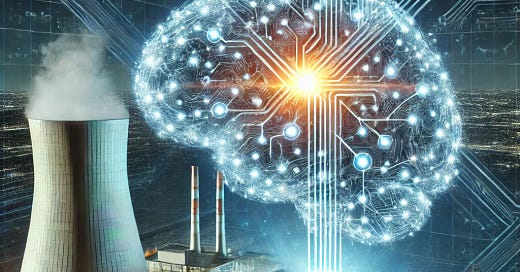AI and Nuclear Power: The Case for Building Mega-Reactor Centers to Fuel the AI Revolution
A Business Case for Large Multi-Reactor Power Plants
As artificial intelligence (AI) rapidly transforms industries, some of the world’s most influential business leaders—Sundar Pichai (Google), Elon Musk (Tesla, OpenAI), Satya Nadella (Microsoft), and Alex Karp (Palantir)—have made it clear that AI is their top investment priority. Sundar Pichai has compared AI’s significance to that of electricity or fire, while Elon Musk acknowledges both the immense promise and existential risk posed by AI. Satya Nadella is positioning Microsoft at the forefront of the AI race with massive infrastructure investments. Meanwhile, Alex Karp of Palantir sees AI as critical for achieving global dominance in the defense sector, with significant military budgets backing AI development.
As AI continues to advance, the demand for stable, massive, and uninterrupted electricity has already skyrocketed, particularly for the data centers that power these systems. Mega data centers, especially those focused on AI processing and cloud services, are predicted to consume 1000 to 1500 MW or more.
Electricity supply is rapidly becoming the major bottleneck for today’s most prioritized technology investments. In the U.S., energy shortages are already causing waitlists for future electricity capacities, as existing power grids struggle to keep up with AI's growth. Companies like Microsoft, Amazon, Google, and Oracle have already begun forming direct partnerships with energy providers, including nuclear facilities, to secure stable energy supplies. For example, Microsoft is currently working with Constellation Energy to revive the Three Mile Island nuclear plant to meet the energy demand of its AI operations.
The Business Case for Large Multi-Reactor Power Plants
Given the surging demand for electricity, the construction of multiple-unit nuclear power plants, featuring several large to very large reactors (such as the AP1000 or EPR models), presents a lucrative and forward-thinking solution. These multi-reactor facilities would provide continuous and reliable power to AI-driven data centers, which require constant, high-capacity energy sources. By ensuring redundant power systems, such plants could shift energy loads between reactors during maintenance or outages, guaranteeing 100% uptime for mission-critical AI operations. This setup would be particularly attractive to tech giants like Microsoft, which has already signed long-term agreements with nuclear providers, and Palantir, where national defense AI applications require uninterrupted power for autonomous warfare systems and data analysis.
Governments are increasingly supporting nuclear power as part of their clean energy transition. A multi-reactor nuclear plant colocated with data centers could receive regulatory fast-tracking, especially if the project aligns with broader goals for energy security, national security, grid burden reduction, and decarbonization.
Energy Efficiency and Other Synergies
In addition to providing stable electricity, colocating nuclear power plants with data centers would create numerous synergy opportunities.
For example, shared cooling tower infrastructure could efficiently serve both the nuclear reactors and the data center equipment, reducing operational costs and increasing energy efficiency.
Shared Security and Physical Infrastructure: Nuclear plants and data centers both require high levels of security. By colocating the two, the businesses could share costs for security measures, infrastructure development (roads, connectivity), and operational logistics (e.g., site monitoring, maintenance personnel).
R&D Opportunities: Nuclear plants and AI data centers are both heavily regulated and rely on cutting-edge technologies. Sharing a site could lead to collaborative R&D efforts, especially in areas like energy optimization, cooling, and cybersecurity.
Decarbonization Efforts: Nuclear electricity production will also support the decarbonization goals of companies like Amazon and Google, which have committed to achieving net-zero emissions.
Peak Shaving and Grid Services: A multi-reactor plant could help balance grid loads by providing peak shaving services during high-demand periods. This could generate additional income, as the plant could sell excess power to the local grid during times of high demand, particularly if its reactors are operating at full capacity.
Conclusion: A Unique Opportunity in the AI Era
The combination of AI’s exponential growth and the surging energy needs of AI data centers has created a unique business opportunity for the nuclear industry. With Power Purchase Agreements (PPAs) from tech giants ensuring long-term revenue, the construction of large multi-reactor nuclear plants would not only address the urgent energy demands of AI but also capitalize on green energy trends and provide unparalleled stability. For investors and governments alike, this marks a critical moment to build the energy infrastructure necessary to support the AI-driven future.




